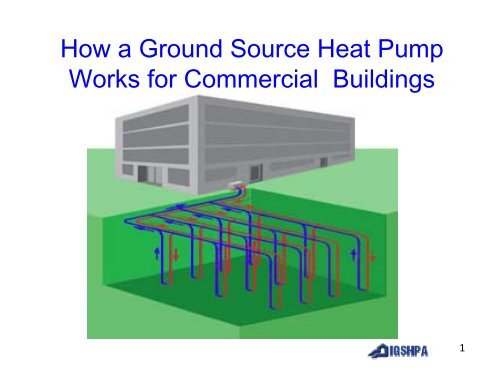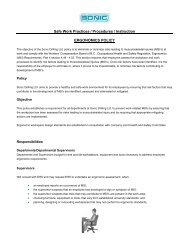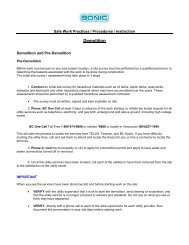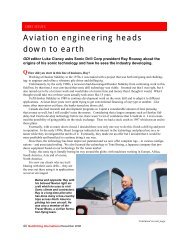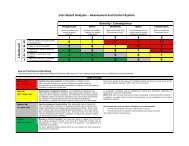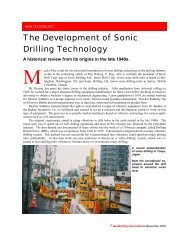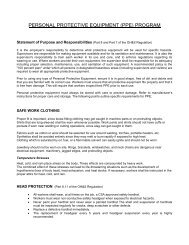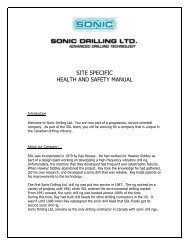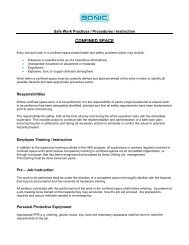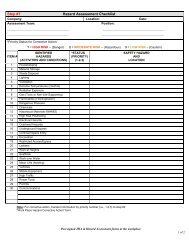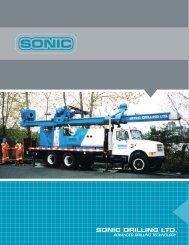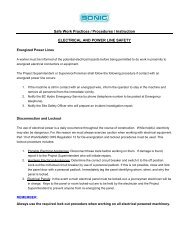How a Ground Source Heat Pump Works for ... - Sonic Drilling Ltd.
How a Ground Source Heat Pump Works for ... - Sonic Drilling Ltd.
How a Ground Source Heat Pump Works for ... - Sonic Drilling Ltd.
You also want an ePaper? Increase the reach of your titles
YUMPU automatically turns print PDFs into web optimized ePapers that Google loves.
<strong>How</strong> a <strong>Ground</strong> <strong>Source</strong> <strong>Heat</strong> <strong>Pump</strong><br />
<strong>Works</strong> <strong>for</strong> Commercial Buildings<br />
1
Geothermal avoids the need <strong>for</strong><br />
outdoor equipment…<br />
..reducing vandalism and liability<br />
Image courtesy of Climate Master<br />
2
Why geothermal heat pumps<br />
City Center, Corcoran City, Mn<br />
FarmTec Supply, Dyersville, Iowa<br />
•Freeand renewable<br />
source of stored<br />
energy…ground.<br />
• Savings up to 70% <strong>for</strong><br />
heating, cooling, and<br />
hot water<br />
• Quiet and Enhanced<br />
Com<strong>for</strong>t<br />
• Reliable and<br />
Environmentally<br />
Friendly<br />
3
Installed Geothermal <strong>Heat</strong> <strong>Pump</strong>s<br />
Holy Cross Lutheran Church, Maple Lake, Mn<br />
Metropolitan Housing Trust<br />
HQ Raleigh Sq Nottingham UK<br />
Martin Kroencke & Sullivan John Deer Dealership, Quincy, Ill<br />
4
Benefits-Geothermal <strong>Heat</strong>ing and Cooling<br />
• Operating unit inside and heat<br />
exchanger loop is<br />
underground…no external<br />
compressor<br />
• Low operating and maintenance<br />
cost 25% to 50% less than<br />
conventional system.<br />
• High energy efficiency all year<br />
long<br />
• GSHP are among the quietest<br />
ever designed…similar to a<br />
refrigerator in sound.<br />
• Geothermal has no flame, no flue,<br />
no odors, and no danger of fire or<br />
fumes and a long life.<br />
5
Benefits-Geothermal <strong>Heat</strong>ing and Cooling<br />
<strong>Heat</strong><br />
Cool<br />
• Natural dehumidification<br />
• <strong>Heat</strong> one zone or room and<br />
cool the other at the same time.<br />
• Less space <strong>for</strong> equipment –<br />
more space <strong>for</strong> offices or<br />
storage.<br />
• Geothermal systems deliver<br />
"even" space conditioning year<br />
round and increased<br />
dehumidification during hot<br />
summer weather.<br />
6
Benefits-Geothermal <strong>Heat</strong>ing and Cooling<br />
Little Red School House<br />
Onamia, Minnesota<br />
80,000 sf, Built in 1992<br />
560 Boreholes, depth<br />
of 50 feet each, 230 Tons<br />
Cooling Capacity<br />
• You can get heating, central air<br />
conditioning, and domestic hot water,<br />
three important benefits from a single<br />
compact unit.<br />
• Dependable, Reliable, Long Service<br />
Life<br />
• <strong>Ground</strong> Loop Tubing warranties of 50+<br />
years<br />
• Virtually Free Domestic Hot Water<br />
• Boilerless/Towerless operation<br />
• Significantly reduce full time<br />
maintenance staff and eliminate boiler<br />
maintenance<br />
7
Benefits-Geothermal <strong>Heat</strong>ing and Cooling<br />
Eliminate cooling tower<br />
• Eliminate chemical and other<br />
costs associated with the<br />
prevention of scaling and<br />
bacterial growth<br />
• Eliminate year-round tower<br />
operation that requires a lot of<br />
expense especially during the<br />
colder weather months<br />
• Low source energy use and<br />
low air pollutant emissionsgreen<br />
technology<br />
8
<strong>How</strong> do you<br />
get earths<br />
energy<br />
100%<br />
17% reflected<br />
by clouds.<br />
Space<br />
6% reflected<br />
by surface.<br />
19%<br />
absorbed<br />
by water<br />
vapor, dust<br />
4% absorbed<br />
by clouds.<br />
Atmosphere<br />
9<br />
46% absorbed by ground<br />
Earth<br />
The earth is like a solar battery absorbing nearly half of the sun’s<br />
energy. The ground stays a relatively constant temperature<br />
through the seasons, providing a warm source in winter & a cool<br />
heat sink in summer.<br />
9
<strong>How</strong> do you get earths energy<br />
• Earth absorbs almost 50% of all solar energy<br />
and remains a nearly constant temperature of<br />
50°F to 70°F depending on geographic location.<br />
• <strong>Heat</strong>ing-In winter, water circulating inside a<br />
sealed loop absorbs heat from the earth. Here it<br />
is compressed to a higher temperature and sent<br />
as warm air to your indoor system <strong>for</strong> distribution<br />
throughout your building.<br />
• Cooling-In the summer, the system reverses and<br />
expels heat from your building to the cooler<br />
earth via the loop system. This heat exchange<br />
process is not only natural, but is a truly<br />
ingenious and highly efficient way to create a<br />
com<strong>for</strong>table climate in your building.<br />
10
<strong>How</strong> the earth works to save you energy! Cooling<br />
Geo4VA - This is a Special Energy Project funded by the U.S. Department of Energy's State<br />
Energy Program through the Virginia Department of Mines, Minerals, and Energy.<br />
11
<strong>How</strong> the earth works to save you energy! <strong>Heat</strong>ing<br />
Geo4VA - This is a Special Energy Project funded by the U.S. Department of Energy's State<br />
Energy Program through the Virginia Department of Mines, Minerals, and Energy.<br />
12
Parts of a <strong>Ground</strong> <strong>Source</strong> <strong>Heat</strong> <strong>Pump</strong> System<br />
<strong>Heat</strong> <strong>Pump</strong><br />
<strong>Ground</strong> Loop<br />
Duct work<br />
• <strong>Ground</strong> Loop<br />
(geoexchange)<br />
– Closed loop (most used)<br />
– Open loop<br />
• <strong>Heat</strong> <strong>Pump</strong><br />
– Water to Air HP<br />
– Water to Water HP (floor<br />
heating)<br />
• Distribution System<br />
–Duct work<br />
– And/or Hydronic-water in<br />
piping in floor.<br />
13
<strong>Ground</strong> Closed Loop System<br />
Trenching<br />
• Trenching-horizontal loops with one or<br />
more pipes in loops. 4’-6’ deep.<br />
• Or Vertical Boring – vertical loop bore<br />
hole with one pipe down hole looping<br />
back to surface. Restricted space.<br />
• Or Directional Boring - horizontal loop<br />
that can be under a building (limited<br />
space).<br />
Vertical Boring<br />
Directional Boring<br />
14
<strong>Ground</strong> Open Loop System<br />
<strong>Heat</strong><br />
<strong>Pump</strong><br />
Delivery<br />
Well<br />
• <strong>Ground</strong>water systems -<br />
groundwater is available at<br />
reasonable depth and<br />
temperature.<br />
• The groundwater is pumped<br />
from the delivery well to the<br />
heat pump and from there to<br />
the sink well.<br />
Sink Well<br />
15
Lake or Pond Closed Loop System<br />
Image courtesy of<br />
McQuay International<br />
• Lake or pond – loops in<br />
water will require some<br />
horizontal trenching from<br />
house to the pond or lake.<br />
• Lake level must be<br />
sustainable during dry<br />
season and at least deep<br />
and large enough to<br />
maintain temperature during<br />
drought periods.<br />
16
Chiloquin Community Center 2003<br />
Geo- <strong>Heat</strong> Center<br />
• Southern Oregon, East of Cascades<br />
• Art Gallery, Library, Meeting Hall, Sherriff<br />
Dept<br />
• 13,000 ft 2 single story, Radiant floor H/C<br />
• 16 Vertical Boreholes 300 ft deep<br />
• Annual HVAC Energy Use<br />
5.8 kWh/ft 2 = $5,350 $.41/ft 2<br />
17
Several <strong>Heat</strong> <strong>Pump</strong>s within Building<br />
Duct<br />
<strong>Heat</strong> <strong>Pump</strong><br />
Image courtesy of Climate Master<br />
Constant<br />
temperature<br />
circulated<br />
water<br />
• Water to air heat<br />
pump <strong>for</strong> duct<br />
heating and<br />
cooling<br />
• Water to water<br />
heat pump <strong>for</strong><br />
use as Radiant<br />
Floor <strong>Heat</strong>ing,<br />
Baseboards, and<br />
Fan coil<br />
heating/cooling.<br />
18
Distribution Systems-Duct Work<br />
• Warm or cold air blown<br />
through ducts<br />
• Zone Control and/or<br />
Remote Master Control<br />
(one room heating and<br />
another room cooling)<br />
• Outstanding Com<strong>for</strong>t<br />
Innovative Air Systems<br />
19
Distribution Systems-Hydronic Systems<br />
• Hydronic Systems –<br />
Floor <strong>Heat</strong>ing<br />
providing warm water<br />
distributed in floor<br />
• Room Zone Control<br />
• Outstanding Com<strong>for</strong>t<br />
• When your feet are<br />
warm your body feels<br />
warm too.<br />
20
Cost and Payback<br />
• A <strong>Ground</strong> <strong>Source</strong> <strong>Heat</strong> <strong>Pump</strong> System will<br />
cost more than a conventional system, but<br />
payback will usually be 2-8 years.<br />
U.S. Department of Energy<br />
• <strong>How</strong> much more depends on where your<br />
building is located and which GSHPS you<br />
use.<br />
•Costdepends on available contractors who<br />
are accredited installers in your area.<br />
• Open Loop systems do not require some<br />
specialized contractors such as drillers and<br />
trenchers and are less affected by this<br />
problem.<br />
21
According to the Geothermal <strong>Heat</strong><br />
<strong>Pump</strong> Consortium:<br />
The current impact of geothermal<br />
heat pump technology is<br />
equivalent to:<br />
•Takingover 1,165.000 cars off<br />
the road<br />
• Planting more then 346 million<br />
trees<br />
• Reducing U.S. reliance on<br />
imported fuels by 19.3 million<br />
barrels a year.<br />
22
The Emergency Economic<br />
Stabilization Act of 2008, H.R. 1424<br />
• The bill extends tax incentives <strong>for</strong> homes and<br />
commercial buildings that support the installation<br />
of highly-efficient heating, cooling, and water<br />
heating systems, such as geothermal heat<br />
pumps until the year 2016.<br />
• Tax credit <strong>for</strong> residences $2,000 maximum<br />
• 10% Tax credit <strong>for</strong> commercial installations.<br />
• To qualify, the systems must meet or exceed<br />
EnergyStar requirements and be installed after<br />
December 31, 2007.<br />
http://financialservices.house.gov/essa/essabill.pdf<br />
23
<strong>Ground</strong> <strong>Source</strong> <strong>Heat</strong> <strong>Pump</strong>s*<br />
• Have the lowest life cycle cost of any<br />
HVAC available today.<br />
• Is considered the technology of choice by<br />
the Department of Energy and the<br />
Environment Protection Agency.<br />
• Will normally cost about 25% more than<br />
the least expensive roof top units or split<br />
systems that are available but will pay<br />
back that 25% extra cost between two<br />
and three years.<br />
*<strong>Ground</strong> <strong>Source</strong> <strong>Heat</strong> <strong>Pump</strong>s: A Good Fit For Schools<br />
By: John M. Vander<strong>for</strong>d, Vander<strong>for</strong>d and Associates - Tuesday, Jan 24, 06<br />
24
<strong>Ground</strong> <strong>Source</strong> <strong>Heat</strong> <strong>Pump</strong>s<br />
provide the following advantages:<br />
McDonald’s-Pensacola Florida<br />
Owned by John and Susan O’Connor<br />
Geothermal <strong>Heat</strong> <strong>Pump</strong>s<br />
55 boreholes 350 deep<br />
• Best Regulated Com<strong>for</strong>t<br />
• Lowest Maintenance<br />
and Longest Equipment<br />
Life Cycle<br />
• Reasonable First Costs<br />
• Lowest Energy Costs<br />
• Adaptability to new and<br />
retrofit design<br />
http://www.igshpa.okstate.edu<br />
25


